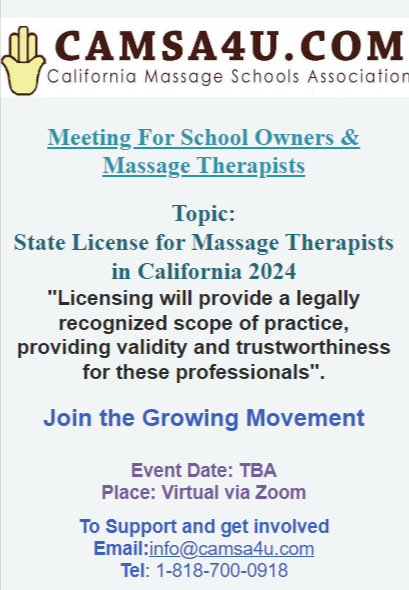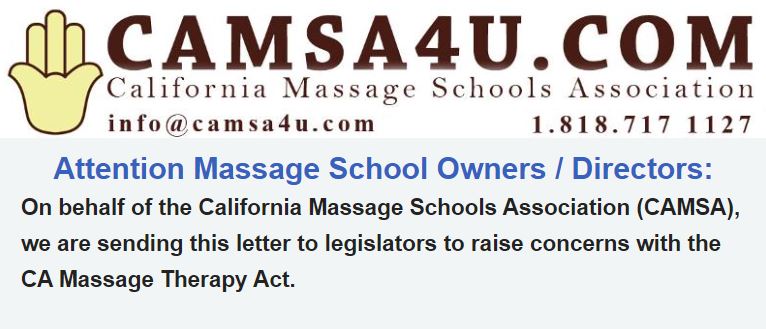Education is a sensitive and divisive topic within the massage therapy profession.
On one side of the argument are those who believe that today’s non-degree vocational school system is both egalitarian and in line with traditional massage therapy practices.
On the other are those who believe the current system penalizes those who want to become full participants in the health care industry. They advocate for an educational spectrum that also includes bachelors and advanced degrees. But while some form of tiered credentialing seems to be the preferred solution on both sides of this argument, it seems there are many directions for that path to take.
“I know there’s a segment of the massage population that wants to increase the hours and scope of practice for massage therapists. They want to see more evidence-based massage research and more acceptance by the allopathic medical field,” said Cherie Sohnen-Moe, WIBB blogger, author and business coach. “While I would like to see this as an option, I don’t want to see it as the main path for massage. If we do this, we will be pricing massage out of the range of the average person. As it is, most people claim they can’t afford a massage on a regular basis, if at all.”
massage education Monetary arguments can be powerfully persuasive in a profession where the average salary can hover around $30,000 per year for experienced therapists and around $10,000 per year for a first-year therapist.
“The more training you require for entry, the higher the cost of the training, the more evidenced-based you need to be to justify it, the more people you eliminate from practice and the higher the cost to the consumer,” said Keith Eric Grant, senior instructor of sports and deep tissue massage at the McKinnon Institute in Oakland, Calif., and a board member of the California Massage Therapy Council.
However, others suggest that advanced degrees can present new and important opportunities for therapists and consumers.
“Having advanced degrees available in massage therapy will open many doors for us in the research world and in the public health policy world,” said Ruth Werner, President of the Massage Therapy Foundation. “It is so frustrating to realize that right now we are missing out on a once in a lifetime opportunity to be in on the beginning of a new health care paradigm that encompasses preventive care and wellness. We’re doing our best, but it is an uphill battle largely because of this educational disparity.”
Portrait of the Profession
Most therapists today are female, in their early 40s and enter the profession as a second career, according to recent studies by the American Massage Therapy Association (AMTA) and market research done by Massage Today. The industry itself was estimated to be $12 to $17 billion in 2010. According to a 2010 U.S. Department of Labor estimate, employment for massage therapists is expected to increase 19 percent from 2008-2018, faster than average for all occupations. According to the AMTA study, between July 2009 and July 2010, approximately 48 million adults received a massage at least once.
Most therapists work an average of 15 hours a week providing massage (this includes time spent on other business related tasks). Therapists charge an average of $60 for a one-hour massage and earn an average wage of $41 an hour (including tips) for all massage-related work. The AMTA study also found that today’s therapists are heavily reliant on repeat business. The average annual income for a massage therapist in 2010 (including tips and working approximately 15 hours per week) was estimated to be $31,980.
Current Education and State Regulation
According to the AMTA survey, there are more than 300 accredited massage therapy schools nationwide and nearly 90,000 nationally certified therapists. What does it mean to be nationally certified? According to the National Certification Board for Therapeutic Massage and Bodywork (NCBTMB), to meet this standard, a therapist must demonstrate a mastery of core skills and knowledge, pass an exam, adhere to a code of ethics and established standards of practice and take part in established continuing education standards.
Massage therapists have an average of 660 hours of initial training and take an average of 22 hours of continuing education per year. Perhaps the most interesting piece of information from the AMTA study was that 92 percent of massage therapists strongly or somewhat agree there should be minimum education standards for massage therapists.
An argument can be made that you really can’t look at massage education without looking at the regulation of the industry, as the regulation generally set the educational criteria that must be met. Currently, 43 states and the District of Columbia regulate massage therapists or provide voluntary state certification. And with that certification, a specific educational requirement must be met. However, each state is different in what they require to be considered certified or licensed. For example, the state of Texas requires 500 hours of board-approved education, while Alabama requires 650 hours, Arizona requires 700 hours and the state of New York requires 1000 hours.
Not only are the number of hours different, so too is the mix of classes the various states require. For example, according to the Texas Department of State Health Services, its 500 hours of massage therapy course work must be “directly related to the theory or clinical application of theory pertaining to the practice of massage therapy and the manipulation of soft tissue, massage therapy laws and rules, business practices, professional ethics, anatomy, physiology, hydrotherapy, kinesiology, pathology or health and hygiene.” While the New York State Education Department requires its 1000 hours to be “complete coursework in anatomy, physiology, neurology, myology or kinesiology, pathology, hygiene, first aid, CPR, infection control procedures, the chemical ingredients of products that are used and their effects, as well as the theory, technique and practice of both oriental and Western massage/bodywork therapy. Within the 1000 hours of education, you will have to complete a minimum of 150 hours of practice on a person.”
“I think massage therapy education the way it is today is a natural outgrowth of many factors,” said Werner. “The advent of Title IV funding was, predictably, a blessing and a curse. It actually made massage school more expensive, but also made it more accessible to a wider market. You can also argue that it raised the bar for minimum expectations above what people in my generation of students got from one teacher teaching every aspect of a course.”
It can be argued that with so many accredited schools nationwide and requirements varying from state to state, that this educational environment only seems to perpetuate the problems involved in portability and the perception among other health care professionals that massage therapists might not be qualified to be a contributor on the health care team.
Grant believes more needs to be done in the current system before degree programs should be considered. “Current 500-hour requirements are very vaguely defined in terms of evidence-based outcomes. If we are truly interested in credibility, then we have a lot more that can be done in terms of validity and reliability (consistency) within the hours we already are requiring,” Grant said.
Werner agrees that standardization is important. “One major factor is that each accrediting agency has different standards and schools often choose whichever is the least expensive to work with, or the least expensive to comply with. I don’t know much about the accrediting process, but I know that some accredited secondary or vocational school systems don’t have requirements about the order in which people take classes — they just put people in the stream and hope for the best — then you get students who are learning deep tissue massage before they learn anatomy. Who thinks that’s a good idea? But the institution is accredited and it’s the cheapest way to put people through the system, and who gets short-changed? The student.”
Ralph Stephens, a nationally recognized massage therapist, author, and continuing education provider believes that, “until we have standards for massage therapy instructors, degrees will not in and of themselves accomplish much of anything.” Stephens thinks any changes made in education must be done with one question in mind, “what will provide the public with a better massage?”
The Debate
The issue of portability has been a longstanding thorn in the profession’s side for many years now. One possible solution being considered is tiered credentialing, that is, a system that includes college baccalaureate degrees and beyond.
“Their was a time when I felt like our profession could not handle tiered credentialing because it is just so hard to organize massage therapists,” Werner said. “But as I have seen more [through my work with the Massage Therapy Foundation] about what the potential for our profession is if we make the opportunity for people who want to pursue advanced education — but we should not require it.
“I’m determined that however our profession moves forward when we think about the evolution of our education, there needs to be space for people who are not bookish, but do their work and they do it brilliantly, as long as they do it safely. But what we’re missing now is space for people who are bookish.
“Right now, if you want to get an advanced degree in massage, what we’re talking about is a master’s or PhD in public health, nursing, psychiatry or gerontology. Those are the only advanced degrees I know of. It’s time for us to have bachelors, masters and doctoral degrees in massage therapy — and not for everybody — but for the people who want to do it,” Werner said.
However, not everyone feels this is the best move forward for the profession.
“Our traditional medical system is a failure, why jump on that boat when it’s sinking?” asks Sohen-Moe. “In terms of baseline requirements, it does not take a rocket scientist to perform a safe, effective massage. While I am personally an advocate of lifelong learning and would hope that practitioners would choose programs that offer some depth as well as breadth, basic programs need to be offered.”
Stephens wholeheartedly agrees. “We need to reach the public with a better product as an alternative to the allopaths, working with other alternative providers to challenge the monopoly of the pharmaceutical-allopathic cartel.”
However, this leads to the question, if an expanded scope of practice were offered with degree-level training, which theoretically leads to more acceptance by the allopathic medical field, would more patients seek out massage as an option for care of pain management or musculoskeletal issues as opposed to seeking out a prescription for drugs? Ultimately, would this type of program lead to more acceptance in the mainstream health care community and are massage therapists ready to play in that field?
Ruth Werner absolutely thinks so. “There is a new emphasis on wellness and prevention and massage deserves a seat at that table and can absolutely play in that playing field, but if we scream and kick and pound our fists and demand a seat at that table, people with doctorates will look at us and say, ‘500 hours? Really?’
“The amount of money spent on massage therapy research is not commensurate with the amount of money the public spends on it and the reason for that is that there are not enough people who know how to write a good grant proposal,” Werner said. She continues, “the reason there aren’t enough people who know how to write a good grant proposal is because there is not a good degree program for massage therapists.”
Those that feel massage therapy is generally less scientific and more about the art of touch, say that something important will be lost if the profession pushes ahead with an advanced degree program.
“I fear the loss of the art of massage as we swing the pendulum to the scientific aspect of massage,” said Sohnen-Moe. “I’ve already witnessed a lot of that change in the past 15 years. Less and less people get into this field as a calling. I’ve had many technically accurate massages, but the newer practitioners seem to have something missing in their work.
“I think the way to go about addressing the education issue is to have specialty national certifications rather than advanced degrees. While I know this is a difficult and expensive process, I really think it’s the way to go,” said Sohnen-Moe. “We need to make sure our core competencies are there. Board certification is more valuable and gives us much more credibility. Doesn’t it sound better to say, ‘I am a massage therapist board certified in…whatever your specialty is.'”
And yet there are still others who feel the time for action in this area is now.
“There are enough of us who are standing up and saying there is a segment of our profession that needs to step it up and accept those higher standards and stop trying to get everyone to agree because we’re not going to agree,” said Lisa Curran-Parenteau, WIBB blogger and marketing and practice development specialist. “Let that natural separation happen. I love the nursing model. You’ve got nurse practitioners, registered nurses and licensed nurse practitioners and they all have a great vocational opportunity for themselves and they all spent different amounts of money for their education. They have a structure and everybody knows that it is and it’s portable.”
Is it now time for the profession to take responsibility for itself and the direction it wants to go? Is it time for therapists to “step it up” to market themselves and effectively communicate their experience and education? With licensure not required in all states, no portability, no defined education standards or consistent school requirements, does moving to a degree program make the most sense in providing a legitimate platform for qualified and motivated therapists to compete in this evolving health care landscape?
Where do you stand in this debate? Do you think that more people will be dissuaded from entering the profession because of the increase in educational costs if the profession required a degree? Do you think there should be a tier system with a college-level degree as an option? If there was a degree option, do you think more people would choose massage therapy as a first career rather than a second? Do you think a degree would provide more legitimacy in the mainstream health care system?




Speak Your Mind
You must be logged in to post a comment.